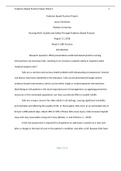Evidence-Based Practice Paper Week 5 1
Evidence Based Practice Project
Laura Chestman
Walden University
Nursing 4100: Quality and Safety Through Evidence-Based Practice
August 11, 2018
Week 5: EBP Practice
Introduction
Research question: What preventative evidenced-based practice nursing
interventions can decrease falls, resulting in an increase in patient safety in inpatient adult
medical-surgical units?
Falls are a common and serious health problem with devastating consequences. Several
risk factors have been identified in the literature. Falls can be prevented through several
evidence-based interventions, which can be either single or multicomponent interventions.
Identifying at-risk patients is the most important part of management, as applying preventive
measures in this vulnerable population can have a profound effect on public health.
Falls are a major concern for older adults in all settings, causing significant morbidity
and mortality and affecting the quality of life. In the hospital, falls occur at an estimated rate of
8.9 per 1,000 patient days. About 30% to 50% of these falls cause injury. Falls increase hospital
stays and may necessitate a long-term stay (Wexler, S. and D'Amico, C., 2015).
A fall-risk assessment is required for all patients on admission, transfer to a new unit,
after a change in the level of care or the patient’s condition, and after a fall. Because falls have
Page 1 of 15
, Evidence-Based Practice Paper Week 5 2
multifactorial causes, the healthcare team should collaborate in the comprehensive
assessment. Risk factors for falling include previous falls, balance impairment, decreased
muscle strength, visual impairment, polypharmacy and/or psychoactive drugs, gait impairment,
depression, dizziness, age older than 80 years, female sex, incontinence, cognitive impairment,
arthritis, diabetes, and pain (Al-Aama, T., 2011).
Analysis
Screening patients for a fall risk are the first step to prevention of falls. When screening
patients for fall risk, check for a history of a fall within the past year, orthostatic hypotension.
impaired gait or mobility, altered mental status, incontinence, and sedative-hypnotic
medications. Various interventions have been shown to decrease the risk and the rate of
falls.
Interventions that are proven to prevent falls include home assessment and modification for
highrisk individuals, exercise programs that include strength, gait, and balance exercises, such
as physiotherapy or Tai Chi. Vitamin D supplementation in doses greater than 700 IU/day for
longterm residents (Al-Aama, T. (2011).
It has been shown that age, functional status, fatigue, radiation, surgery, chemotherapy,
endocrine therapy, anemia, nutritional status, and depression were factors associated with
falls. It was found that gender, cognitive status, and medication use were not found to be
predictive of falls (Melin, C. M., 2018).
Other interventions that are likely to be beneficial for prevention of falls include
reviewing the patient's medications; check to see if they are on any psychoactive medications




